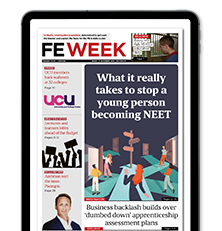It’s worth bearing in mind the lessons of lockdown as we all return to the ‘new normal’, writes Amanda Wayling
There were some very surprising outcomes from our remote teaching and learning experiences over lockdown – including that some of our learners engaged in ways that we couldn’t ever have predicted.
The rapport between teachers and students was noticeable. Learners seemed to understand that teachers were working hard to create content amid highly challenging circumstances. Many of them became more cooperative, made suggestions about delivery of classes, created quizzes, contacted students who may have missed a class and were more confident in being part of the learning process. Very oddly lockdown created, in some ways, a deeply communal environment.
Now we’re back to the “new normal” as socially distanced colleges, and it’s worth bearing some of these lessons in mind. A particularly important lesson we won’t be forgetting quickly is around our neurodiverse students.
Some of them told us they enjoyed the distance created by remote teaching. They could choose when to talk and when to be seen by muting or unmuting their microphone, turning their camera on or off and completing their work in the sanctuary of their homes.
One student, completing his course and about to go off to university, said that virtual lessons meant he didn’t have to worry as much about participating in groups and trying to read and understand the body language of other students. This kind of virtual delivery fits seamlessly with the complexities of neurodiversity.
Meanwhile, self-motivated and independently minded learners are enthusiastic about learning without distractions, at their own place, through virtual lessons.
Teenage anxieties, already heightened, seem to get worse in virtual sessions
But of course, it’s not all positive news. As we move to a blended model of face-to-face and online learning at our college, we mustn’t forget that students with learning needs can also be overwhelmed by the experience.
Without the one-to-one support they can rely on in the classroom, many found it very difficult to accept that they are on track, despite constant reassurance. Our teachers have, like Spiderman, a “Spidey sense” about when a student is in trouble, not engaging, or about to switch off and our Learner Support teams have worked hard to keep our students connected. But it’s still very difficult to replace face-to-face contact.
The other big group that aren’t ready for a switch to more virtual learning are those with poor attendance records or who struggle to maintain focus. The feedback we’ve got from them is that they find remote teaching and instruction difficult to manage as they are more engaged by face-to-face attention and encouragement.
Anyone who has tried to “get in” on a remote conversation will appreciate how hard it is sometimes to interrupt the speaker – as a result, less engaged students often didn’t want to ask questions.
Average teenage anxieties, already heightened, also seem to get worse in virtual sessions. Students turn their camera on if they see others have, leaving the teacher talking to a series of ID symbols on a screen.
On the plus side, classroom management is easier for staff because students only talk to other students in permissible places, like breakout rooms or by using the chat function. This has meant that teachers can focus on teaching and assessment, without having to manage distractions.
So what we need to remember in this new academic year is that remote teaching can be a positive experience. It can enhance learning and allow students to demonstrate their technological competence.
At the same time, the majority of students say they missed being in a class and with their friends. And for neurodiverse students, it has mixed blessings.
This term, we will seek to more closely differentiate and safeguard learners. For instance, we can provide digital backgrounds for the students so that their privacy is secured and still persuade them to turn on their cameras so that the learning environment is alive. We can deliver more flipped learning sessions to challenge and expand knowledge and understanding.
This way, as we begin our blended approach, we hope to ensure no-one falls behind.






I enjoyed reading this and it reflects our experiences during lockdown too. I worry a little that, even with those who fully engage with remote learning, one of the benefits of being away from the home environment is getting students out of their ‘comfort zone’. Even to the point that they feel uncomfortable but then learn a lot about themselves as well as the subject.